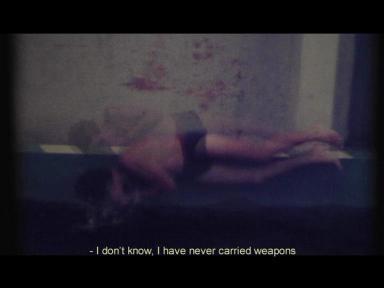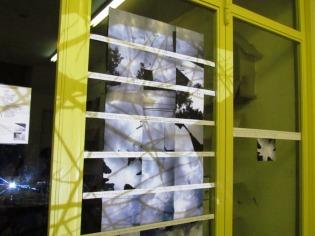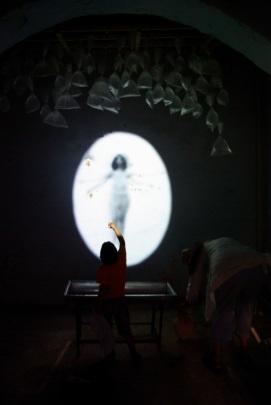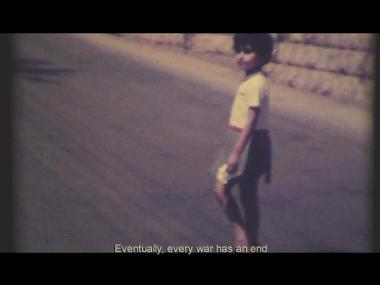 Born in Lebanon in 1982, Lynn Kodeih lives and works in Beirut. After studying literature and theatre, she receives a M.A. in theatre studies, emphasizing on contemporary art. Her work emerging from dramatics deviates from theater practices to performance and installation, where she uses video and photography, experimenting with new media mixed with the raw body of the performer.
Born in Lebanon in 1982, Lynn Kodeih lives and works in Beirut. After studying literature and theatre, she receives a M.A. in theatre studies, emphasizing on contemporary art. Her work emerging from dramatics deviates from theater practices to performance and installation, where she uses video and photography, experimenting with new media mixed with the raw body of the performer.
She acted in and directed several performances, amongst other Coma, Hamlet Machine, Regrets of the Statue Man, and The Invisible City. In her installations Triptych – I am the martyr #187 and Variations on an icon, she reflects on monuments and martyrdom, conceptualizing the human body, a task she attempts to pursue in her video performance 160 feet under pure blue sea.
In this work, Lynn Kodeih juggles with themes such as faces, obliteration, the hero/antihero symbolic image of the father, and she explores the possible ways of narration and testimony. She currently teaches at the Académie Libanaise des Beaux Arts (ALBA) and Université Saint Joseph (USJ) in Beirut.
Can you introduce us one of your work that you consider representative of your artistic approach or which is essential for you?
 I don’t really know if I have a “key” work that can be most representative of my practice. I think that the pieces I have done until today are sort of chained together, they evolve from one another, juggling thematics and notions that create each other.Disappearance, perpetual loss, and evanescence and reappearance are the motifs of several works I am currently elaborating.The loss through its different figures. After having used the body as a tool for performing, conceptualizing it became one of many preoccupations. The loss of the body, its decomposition – even while alive – is a question that had always troubled me; along with the bonds we establish with our flesh, going all the way from our love-hate relationship, to that of the pleasure-pain, and the rituals we appoint with its life and its death. I am also working on the body as a receptacle, a holder of the soul, as the “place” of elaboration of the psyche, of anguish and obsessions thoughts, references, desires and conflicts that drive us; the body as the place of perpetual loss, and eventually, the body as decomposition, hence disappearance.
I don’t really know if I have a “key” work that can be most representative of my practice. I think that the pieces I have done until today are sort of chained together, they evolve from one another, juggling thematics and notions that create each other.Disappearance, perpetual loss, and evanescence and reappearance are the motifs of several works I am currently elaborating.The loss through its different figures. After having used the body as a tool for performing, conceptualizing it became one of many preoccupations. The loss of the body, its decomposition – even while alive – is a question that had always troubled me; along with the bonds we establish with our flesh, going all the way from our love-hate relationship, to that of the pleasure-pain, and the rituals we appoint with its life and its death. I am also working on the body as a receptacle, a holder of the soul, as the “place” of elaboration of the psyche, of anguish and obsessions thoughts, references, desires and conflicts that drive us; the body as the place of perpetual loss, and eventually, the body as decomposition, hence disappearance.

The flow of time, the disappearance and reappearance of elements through stratification of space and time is another idea I base my work upon. Where does a feeling go after it had been felt? What becomes of images after they have been seen? What happens to the parole after it has been said? Furthermore, the speech and its performative aspect holding evidence of subjectivity constitute an important material on which I would like to elaborate upcoming projects. I am therefore interested in the articulation of the parole, its different layers of meaning, and the ability the word has to generate images.
Can you tell us in which extent and how the city or Beirut, its urban dynamics and its history influence your work?
 I have always been fascinated by the architecture, monuments and ruins of the city of Beirut. I think that somehow, all my work is related to this place, not that it does not affect people who do not live here. I see Beirut as a city that never looked at itself and its architecture, at its history. It had always turned her back to the sea, enclosing itself and its citizens. An esthetically confusing city, offensively deformed by its grotesque way of recovering from its own wounds.
I have always been fascinated by the architecture, monuments and ruins of the city of Beirut. I think that somehow, all my work is related to this place, not that it does not affect people who do not live here. I see Beirut as a city that never looked at itself and its architecture, at its history. It had always turned her back to the sea, enclosing itself and its citizens. An esthetically confusing city, offensively deformed by its grotesque way of recovering from its own wounds.

Twenty years after the war has stopped, we can barely locate buildings considered by some as “delayed” vis-a-vis the rapid reconstruction of the city. Hardly noticeable for those “habitués” of the new modern reconstructions, they are blurred by the shiny new malls and sparkling routes with polished street signs. These buildings can be seen as relics from the time of the catastrophe, but also as timely confused compared to the present city. To me, they are proofs of a traumatized city suspended in time, a place that was rebuilt on its own ruins, obliterating the traces of its own war, and thus, continuing it implicitly.
The Invisible City was an ambulant sound performance project and a cartographical reconstruction of the old centre of Beirut that was devastated by the civil wars, an attempt to recreate lost space and time of the age of the city by the eradication of the image and the excavation of the memory through sonic material belonging to our radiophonic culture of that period. I am currently working on another project, One more thing before I go. It is a project that tries to elaborate a new relationship the city and its inhabitants by creating space and time to discover its forgotten parts, the ones we willingly or unwillingly omitted while reconstructing and erasing the traces reminding us of our great failure as citizens.
 Your projects are dealing with the Time and Image, especially their strength and their evanescence. Linked to that, you are interested in showing how History can be rewritten through personal “histories”. Can you tell us more about this approach?
Your projects are dealing with the Time and Image, especially their strength and their evanescence. Linked to that, you are interested in showing how History can be rewritten through personal “histories”. Can you tell us more about this approach?

The exploration of possible means of narration and testimony are the core of 160 feet under pure blue sea. This video performance addresses the subject of remembrance, the feeling of having lost the images that should be printed in my childhood memory, images of chaotic space and time, and a need to see again with the eyes that I had at the time and my present conscience.
Emphasizing on the infinite possibilities of rewriting History through personal “histories”, this work underlines the difference between the voices telling a hypothetically same story, with identical words, but from which emerges continuously the immeasurable differences between us all.
This is also a subject I’m working on in One more thing before I go, an attempt to artistically resurrect parallel events, thoughts, feelings, smiles, pieces of sky, relationships, loves, encounters, words heard, words said or even unspoken, all from those suspended time and place.
This project does not propose to revisit the Lebanese civil warsera, nor to be a war memorial. It is a poetic essay on the notion of loss and passage of time. It is also and most of all an experiment new ways of art creation, with dialogue, writing and poetry.

 Born in Lebanon in 1982, Lynn Kodeih lives and works in Beirut. After studying literature and theatre, she receives a M.A. in theatre studies, emphasizing on contemporary art. Her work emerging from dramatics deviates from theater practices to performance and installation, where she uses video and photography, experimenting with new media mixed with the raw body of the performer.
Born in Lebanon in 1982, Lynn Kodeih lives and works in Beirut. After studying literature and theatre, she receives a M.A. in theatre studies, emphasizing on contemporary art. Her work emerging from dramatics deviates from theater practices to performance and installation, where she uses video and photography, experimenting with new media mixed with the raw body of the performer.
